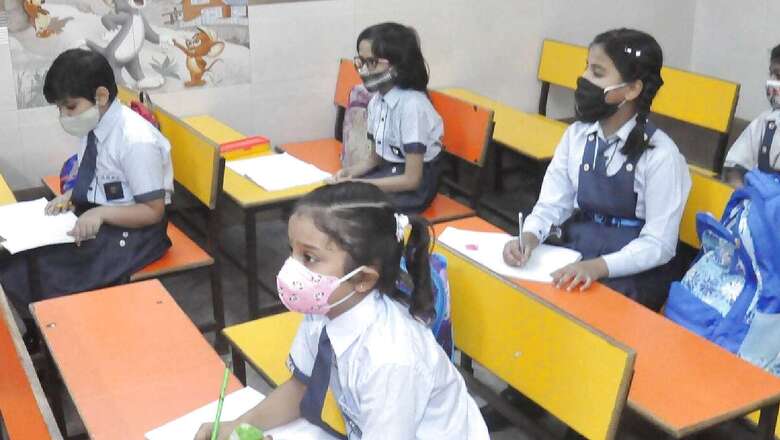
views
As the COVID-19 pandemic continues to send shock waves throughout the world, education is witnessing unprecedented changes. In the wake of lockdowns, educational institutions were forced to adopt e-learning. Teachers had to quickly reimagine teaching pedagogy. Students were expected to conform in the quest to create a ‘virtual reality’ of classroom teaching. Institutes were struggling to seamlessly continue imparting education.
While daily COVID tolls spiked, our virtual classrooms became nerve-centres of activity. Teachers coughed their way through lectures; those that were lucky. Many didn’t even get that chance! Students kept writing assignments, smashing deadlines, making presentations, giving interviews, completing internships. We were applauded for our remarkable professionalism, agility and resilience, even as we lost our near ones. We stayed strong, even as we were crumbling inside.
According to the World Bank, 94 per cent of students – 1.6 billion – were out of educational institutions during lockdowns. The volatility of COVID-19 left the education system shaken. Despite the raging pandemic, teachers across the world deployed innovative use of online teaching.
Education technology took over our learning ecosystem. Digital content and learning platforms resulted in the education sector leapfrogging to the next level. Universities are now offering a wider range of programmes from music to Spanish to quantum physics in online mode. The changing education paradigm spells new equations for dynamic learning environments.
The transition, though promising, has not been easy. Work pressure in COVID lockdown was shattering, said teachers, according to a report in The Guardian. A New York Times report indicated that in a world ‘So Upside Down,’ the virus is taking a toll on young people’s mental health. School children have been worst affected. A study in Lancet indicated that anxiety of missing school and the fear of losing family members has resulted in increased angst among children.
The disruption of societies caused by the pandemic has aggravated the global education crisis. Even before COVID-19 hit, the world was experiencing a learning crisis. An estimated 258 million children were out of school, and the Learning Poverty rate in developing countries was 53 per cent – indicating that over half of all children could not understand simple text. The pandemic has only exacerbated the learning crisis.
Education inequality is worsening in an unprecedented fashion. UNICEF estimates that 463 million children – at least one-third of the world’s total, majority of whom are in the developing world – have no access to online content. The risk of falling behind is likely to result in long-term negative impact on cognitive skills.
As lockdowns have eased, educational institutions are reopening in full swing. Students are already back on campus. The silent corridors are abuzz once again. The challenges, however, are huge. A survey by UNESCO, UNICEF and the World Bank revealed that the major challenge is safety of students and staff. General precautions like social distancing, staggered schedules and creating small “bubbles” have worked well in some countries.
More importantly, strategies need to focus on the reality that as students return, they are in different psychological state(s). Their learning levels are now different and so is their mental preparedness. Teachers and students are expected to fluidly transition from offline to online and back again as if in a smooth shifting of gears. Post-pandemic adjustment would require modifying teaching pedagogy to enable both teachers and students to adapt.
Enforcing unnecessary stringent rules and schedules is doing more harm than good. Getting to terms with reality will require some time and may need flexible and individualised transition curves. Institutions may have to restructure academic calendar to address learning losses. It also mandates curriculum recalibration to prioritise the core content.
ALSO READ | As Schools Begin to Unlock, Teachers Will be Frontline Warriors—But They Must be Trained
Our obsession with examinations is often inexplicable. Young children in many schools who had just emerged out of a two-year stressful hibernation were suddenly greeted with annual exams subjecting them to unnecessary strain. Institutions will have to approach assessments more rationally to maintain rigour while minimising rigidity.
Many students have lost family members, undergone sufferings and faced financial difficulties. They may be held back at home due to family demands. For some time, learning at one’s own pace can help stem learning losses. Remote learning may help, especially for vulnerable and marginalised students, including persons with disabilities. Though difficult, it will go a long way in helping students cope. Incorporating social-emotional learning may be critical. Teachers should be ready to assume the role of facilitators. For a moment let’s stop talking to students about exams and placements, let’s talk to them about their well-being.
The pandemic has substantially increased demands on teachers who need as much emotional support as students. The shifting ‘systems dynamics’ of education is an opportunity that needs to be grabbed. Hybrid learning opens up endless possibilities. But the emphasis on hybrid learning has been more aspirational than practical. This sudden shift has resulted in problems, especially for learners without access to technology.
Acclimatisation with the new realities will require ground-level engagement and multi-stakeholder consultation. Students, teachers, parents, administrators and policymakers may have to come together more than ever before to enable the education system to bounce back. Institutions in high-income countries were better able to cope with the disruption because of government support and funding.
The trajectory of our progression from uncertainty to distress still remains unpredictable. Existence feels fragile. The virus continues to mutate. Younger children are still in the queue for vaccines around the world. The fear of uncertainty is likely to remain for a long time to come.
Reopening academic institutions is no longer a question of ‘when’ but ‘how’. Within three broad buckets – health and safety, pedagogical, and administrative – countries should make an evidence-based decision regarding reopening. Hoping for cheerful times ahead, we should, nevertheless, be prepared for any future shutdowns. Our institutions should learn from the past and emerge stronger and wiser.
Dr Feza Tabassum Azmi is Professor, Department of Business Administration, Faculty of Management Studies & Research at Aligarh Muslim University. The views expressed in this article are those of the author and do not represent the stand of this publication.
Read all the Latest Opinions here


















Comments
0 comment